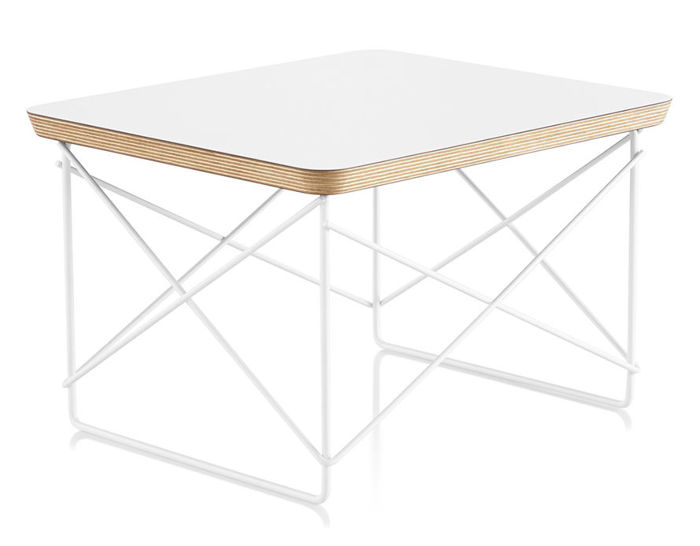eames wire base low table
by Eames ® from Herman Miller ® - sale
eames wire base low table
Design Charles & Ray Eames, 1950
Wire frame, baltic birch core top, veneer or laminate
Made by Herman Miller
"Design is a plan for arranging elements in such a way as best to accomplish a particular purpose."
-Charles Eames
In the late 1940s, Charles Eames noted all the "fantastic things being made of wire." That fascination led Charles and Ray Eames to develop a mass-production technique for simultaneously welding wire rods. One result was the wire-base table introduced in 1950. Practical in so many milieus, the tables gave the Eameses the perfect place to serve chanoyu, the traditional Japanese tea ceremony, to special guests, such as sculptor Isamu Noguchi and film star Charlie Chaplin. Today these lightweight, diminutive tables stand on their own, next to beds and chairs as an accompanying surface, or on top of each other in a convenient stack.
With a grand sense of adventure, Charles and Ray Eames turned their curiosity and boundless enthusiasm into creations that established them as a truly great husband-and-wife design team. Their unique synergy led to a whole new look in furniture. Lean and modern. Playful and functional. Sleek, sophisticated, and beautifully simple. That was and is the "Eames look."
The wire-base tabletop consists of seven layers of Baltic birch plywood, beveled at 20 degrees and sandwiched between veneer, high-pressure laminate or .75" thick stone tops. The base is available in a powder-coat white, studio white, black or trivalent chrome.
15.5" w | 13.25" d | 10" h
Wire frame, baltic birch core top, veneer or laminate
Made by Herman Miller
"Design is a plan for arranging elements in such a way as best to accomplish a particular purpose."
-Charles Eames
In the late 1940s, Charles Eames noted all the "fantastic things being made of wire." That fascination led Charles and Ray Eames to develop a mass-production technique for simultaneously welding wire rods. One result was the wire-base table introduced in 1950. Practical in so many milieus, the tables gave the Eameses the perfect place to serve chanoyu, the traditional Japanese tea ceremony, to special guests, such as sculptor Isamu Noguchi and film star Charlie Chaplin. Today these lightweight, diminutive tables stand on their own, next to beds and chairs as an accompanying surface, or on top of each other in a convenient stack.
With a grand sense of adventure, Charles and Ray Eames turned their curiosity and boundless enthusiasm into creations that established them as a truly great husband-and-wife design team. Their unique synergy led to a whole new look in furniture. Lean and modern. Playful and functional. Sleek, sophisticated, and beautifully simple. That was and is the "Eames look."
The wire-base tabletop consists of seven layers of Baltic birch plywood, beveled at 20 degrees and sandwiched between veneer, high-pressure laminate or .75" thick stone tops. The base is available in a powder-coat white, studio white, black or trivalent chrome.
15.5" w | 13.25" d | 10" h
average rating: 4.5
Eames
The primary need of the human being was an essential component of every design for Eames. They believed a design to be successful when it benefited the greatest number of people.
Herman Miller is synonymous with modern designer furniture. Creative director George Nelson recruited contemporaries Charles & Ray Eames, Alexander Girard and Noguchi to create a legendary furniture collection.














 write a review now
write a review now
